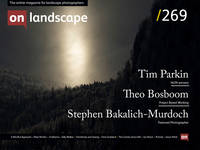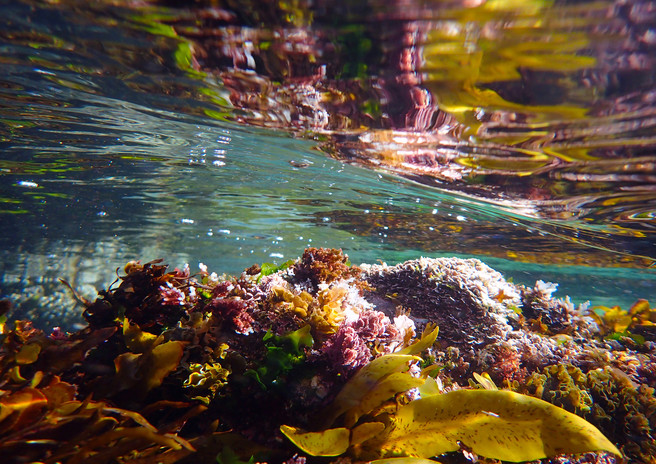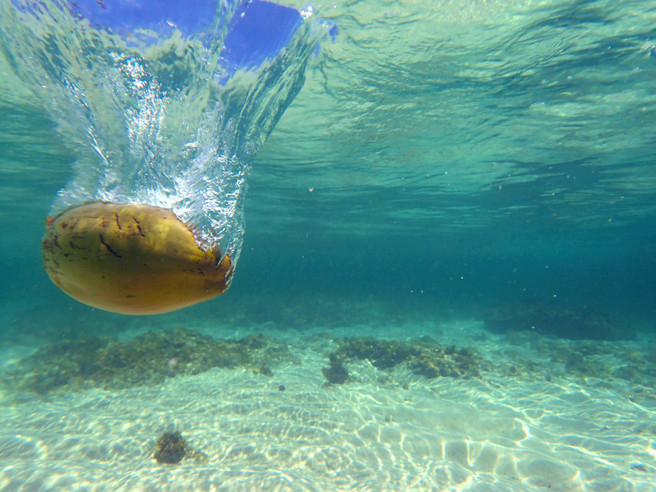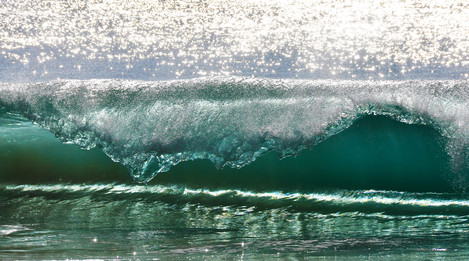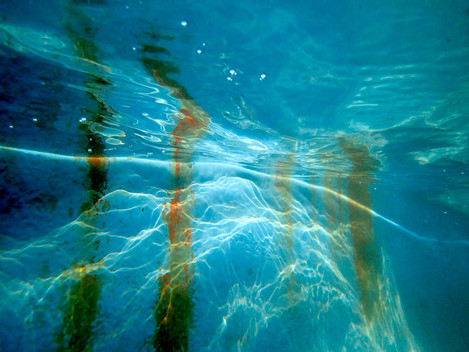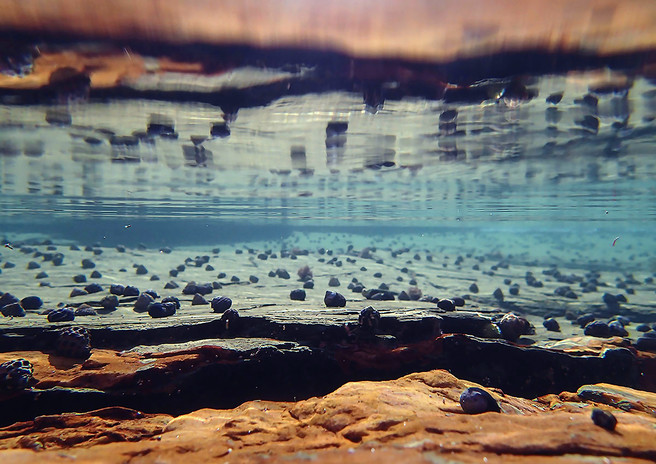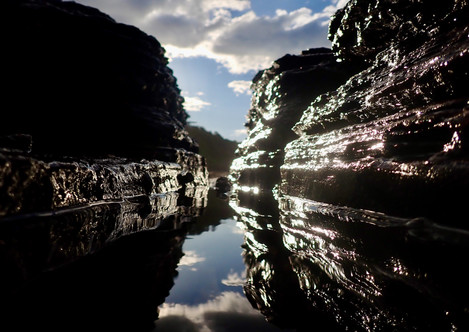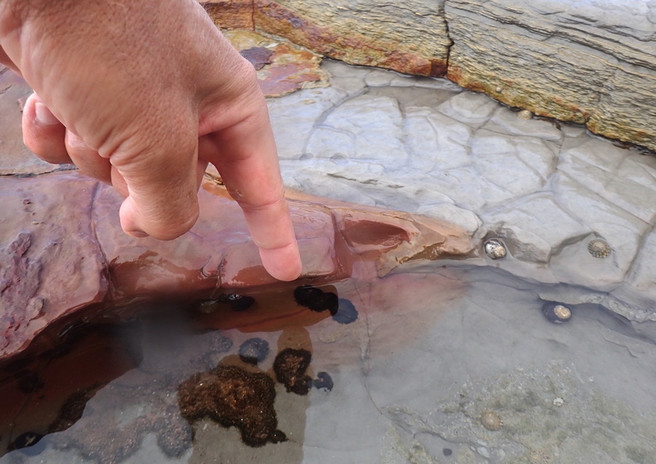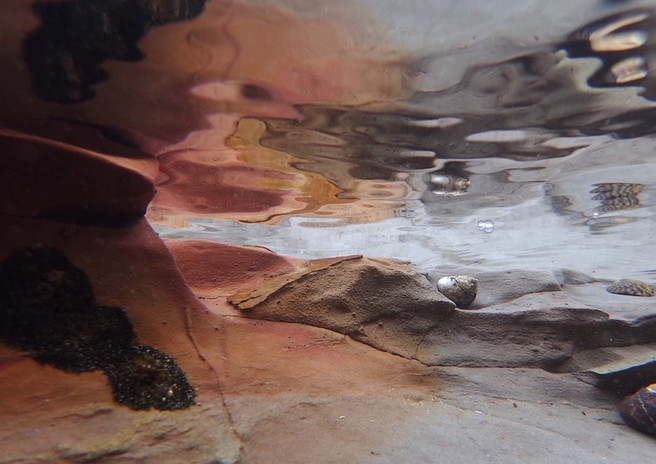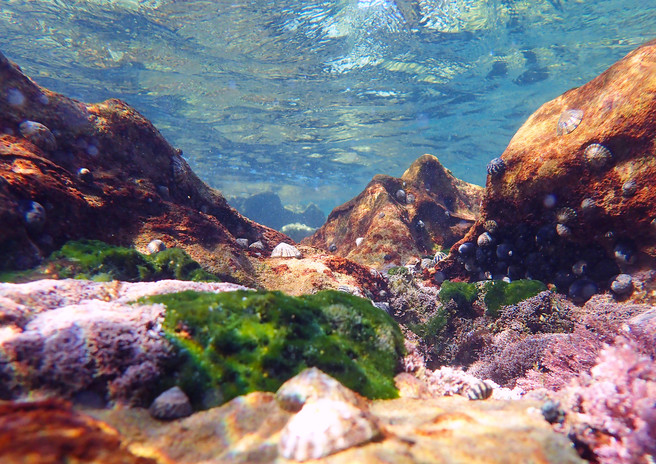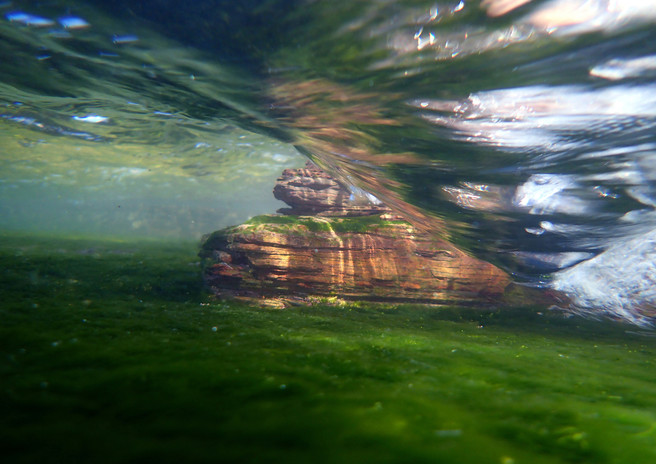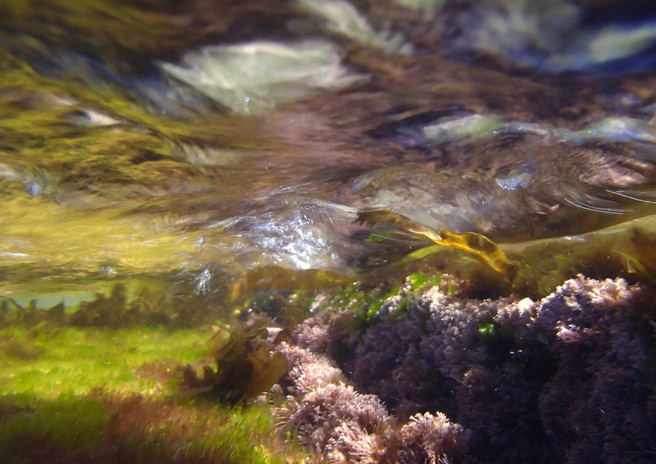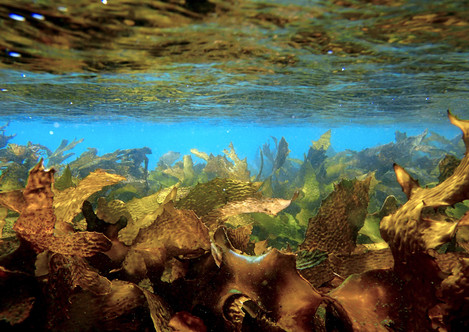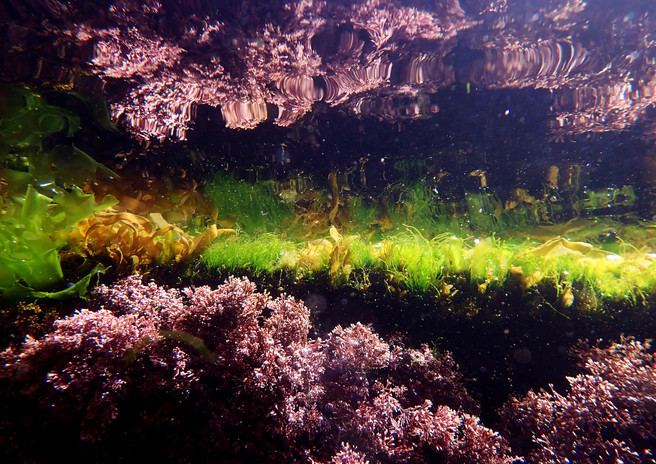Featured Photographer

Stephen Bakalich-Murdoch
Stephen Bakalich-Murdoch is a photographer who explores unique perspectives in coastal environments that challenge perception and scale. He is based in Sydney, Australia.

Michéla Griffith
In 2012 I paused by my local river and everything changed. I’ve moved away from what many expect photographs to be: my images deconstruct the literal and reimagine the subjective, reflecting the curiosity that water has inspired in my practice. Water has been my conduit: it has sharpened my vision, given me permission to experiment and continues to introduce me to new ways of seeing.
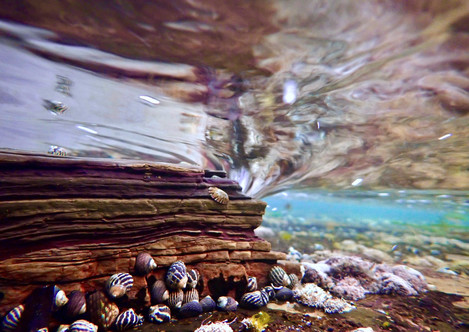
As some of you know, I’ve spent the last ten years photographing water, finding delight often in just a few inches of depth, so when I came across Stephen’s photographs made in shallow tidal water, I was intrigued. Stephen’s website is rich in colourful images of exotic worlds, and while in the past he has had a taste for adventure and a fascination with far lands, it is the nearby that now engages him. It’s interesting when conducting these interviews to see how much comes back to each of us from our childhoods; in Stephen’s case, not only an affinity with water but a fascination with micro worlds and relative scale, which has once again come to occupy him. As he explains on the ‘Ten Below’ project website “In nothing deeper than a few centimetres of water all sense of perspective becomes distorted and reality altered through form, reflection and light… There are alien worlds, desert plains, mountains and forests, all within a crevice, puddle or rock platform hidden in the tidal zone.” Let’s find out more.
Would you like to start by telling readers a little about yourself – where you grew up, what your early interests were, and what that led you to do? How formative was your childhood, growing up by the water?
My childhood was always about activity and creativity. I grew up in a beautiful part of southeast Sydney called Malabar. On its coast is one of the prettiest beaches you'll find in a suburb, Little Bay. As the name suggests, it has a small secluded beach sheltered from the open sea by rock pools and tidal shelves. The golf courses and Crown bushland surrounding the bay made the area magical for a child with a vivid imagination and lots of energy. It was my first experience of really exploring nature. Miniature worlds fascinated me. Looking down, I imagined how vast a small patch of earth or a shallow pool would be to insects and crustaceans. Knowing a few strides would be the equivalent of a drive across a city for the micro world, let alone the distance between the beach and home, always blew my young mind, and it still does.
When did you become interested in photography, and what part has it played in your life so far?
I was a lazy painter in my teens, a capable artist, but I was impatient. It always took too long to create something satisfying. When I discovered capturing an image was better than any painting or drawing I could produce, I was convinced photography was the creative path to take. In my early twenties, I dabbled in shooting bands at live venues and rehearsal studios for a while, but it wasn't until my first extensive travels around the Middle East that I fell for the craft and how freely I could express myself. It was a new world to unravel. For fifteen years, capturing those adventures was my passion and drive. I felt I had stories and perspectives to share about a very misunderstood region.
Every journey ebbs and flows, and it has taken quite a few years to accept that there will be times when I feel inspired and times when I won't. I don't pressure myself if there isn't motivation. Photography has become a grounding, meditative experience that allows me to feel present and alive. In one way or another, creativity is how I live, expressed through my art, soul, body, and mind experiences. My weekday job enables my creative lifestyle, and I'm content with the balance. I'm spending more time out of Sydney than previously, finding little gems to project, so my weekends are generally dedicated to ‘Ten Below’. There is a short documentary in the works too, which is exciting.
Who (photographers, artists or individuals) or what has most inspired you or driven you forward in your own development as a photographer?
Nature has been my biggest inspiration. Everything comes from nature, and everything goes back to nature. It’s one big beautiful cycle. I also find inspiration in the achievements and successes of underdogs, people excelling through adversity and surpassing all expectations. For example, I was walking along Main Beach, Byron Bay, many years ago when I saw a strange shape moving slowly toward me. The closer I got I couldn't believe what I was witnessing. A man in a wheelchair was pushing himself along the compact sand. I was speechless. When we met, I noticed he was saturated in sweat yet grinning. Bewildered, I asked if he needed help. “Nah, mate. I do this every day.” he said. I inquired why, and he responded that it made him feel alive because it was difficult. That blew my mind and was both immensely humbling and inspiring.
Generally, I find the actions of individuals uplifting, such as a song, a deed, a painting, a photo or altruistic behaviour. However, the individuals I hold in the highest regard are more on the philosophical side of history. Marcus Aurelius' Meditations has been a constant go-to when I travel. The Buddhist monk Thich Nhat Hanh's dharma talks inspire mindfulness, compassion and peaceful living. John Pilger's courage in exposing corrupt governments and corporations sparked my social justice warrior. The Tao Ti Ching for its divine simplicity and insight to living in harmony with nature, and Jiddu Krishnamurti for his enlightened teachings: “In oneself lies the whole world, and if you know how to look and learn, the door is there, and the key is in your hand. Nobody on earth can give you either the key or the door to open except yourself.” All have profoundly influenced my journey of self-awareness and, in turn, my creative expression.
You’ve had some adventurous travels and at times, a fascination for other lands. You must have absorbed many things. Has anything in particular stayed with you or encouraged you to look in such close detail at your own country?
I had many visions of deserts, oases, bazaars and ancient civilisations in my youth. These conscious dreams eventually morphed into an obsession with the Middle East. I was curious to know where these visions had their roots, considering my heritage was in no way linked to the region. By the time I made my way through Turkey on the initial journey, that experience had amplified my desire to explore the area further and in challenging, unconventional ways. Four extensive trips over fifteen years had me either hiking, paddling, cycling, bribing, lugging or hitching through Turkey, Syria, Lebanon, Jordan, The West Bank, Israel, Jerusalem and Egypt.
The Middle East isn't exactly known as the friendliest region on earth, although from my journeys, I discovered the hospitality of Muslims is a thing to behold. It wasn't uncommon for people to argue amongst themselves about who would host the strangers. Once resolved, the welcoming and generosity were something I'd never experienced, especially from people considered less than friendly to Western cultures. This perception of hostility proved to be nonsense, in my experience.
I've always considered myself lucky to call Australia home, and I believe travel reaffirmed that. Exploring the world should be about adventures; the good, the bad, and the downright ugly. I've had guns and knives pointed at me, I've been detained by Hezbollah in the Bekaa Valley and conned by shysters everywhere, but nothing as nefarious as being held for a small ransom in Istanbul. That was terrifying. If Istanbul was my favourite city, it quickly became the city I wanted to escape immediately and never look back at.
The most positive travel experiences came from Syria. I fell in love with that country and its people. Hospitality is in their DNA. Everywhere I went, Syrians were friendly and welcoming. Merchants didn't try the hard sell; instead, they would invite me into their shops to share stories over tea, which was consistent throughout all of Syria. Travel taught me, above all else, that we must avoid defining populations of countries by their leadership and politics. Those interactions I encountered throughout my travels dispelled every false impression about the Middle East the media had me believe. Instead of war, terrorism, and hatred of the infidel, I was received and guided through the lands of the crescent moon by people of integrity, humour and hospitality - all with a welcome I'd never experienced in Sydney or any other European country. The beauty of travel is that nothing is what it seems until you see it for yourself; even then, it's only an opinion, not a fact.
What first prompted you to put a camera below the waterline? Was it a transformational moment for you?
Back in 2013, someone, I considered a brother died a slow and painful death. Caring for him in his final months and being by his side as he drew his last breath put me in stasis. I felt no emotion, just emptiness. Every day I'd sit on the beach, watching wave after wave roll onto the shore. Weeks went by then, and out of nowhere came the urge to purchase a point-and-shoot waterproof camera. I didn't know why; I just thought it was something to do. I did fancy the idea of pulling off some fantastic shots of the undersides of waves that were popular then. Suffice it to say my attempts fell far short of inspiring, leaving me very underwhelmed. What did I expect for $120 and no experience in those conditions?
What’s the shallowest and the deepest you’ve worked at? Are you using a camera with waterproof qualities, or when the depth permits, do you work with bigger cameras and waterproof housings?
It all depends on what effect I'm after. If I'm playing with reflection, I'll shoot in depths around 5cm. To 30cm plus, my focus will be on the movement and flow of water. The deepest I go is to my waist when looking for certain aspects of breaking waves over rocks. I still use waterproof Fuji and Olympus point-and-shoots as well as Go Pro. I've managed to print to A1 and A0, despite the small sensors. Any camera capable of shooting in a few centimetres of the shallows will work. For perspective purposes, depths are usually not more than a small glass of water, and the areas are generally around shoe-box size, so there's not much room to move. DSLRs and housings are out of the question, so keeping it simple is the idea. Without focusing on technical aspects, I'm left with time to remain connected to my surroundings. If there's too much adjusting, it can be distracting and disengaging from the presence I'm seeking.
How do you deal with visualisation - composition and focus – and do you change much in post-processing?
Visualisation and composition are a work in progress. Shooting blind presents a few challenges. I've learnt to anticipate what an image will offer when shooting at various angles and utilising degrees of light. Experimenting this way has involved adaptation to the conditions and environment. The time of day, tide, weather, waves, and pollution are elements to consider when shooting and affect how the outcome will look. I usually take time to walk around, just observing. When something catches my eye, I’ll focus on how water responds to the space; is it flowing, churning or still? Sometimes I'll sit and watch waves and set frequency, which is crucial for safety and prepping for a shot.
Are you happy anywhere along the water’s edge, or are there places you are especially drawn to? What are some of the practicalities – time of day, tide, year – and how do you stay safe in what can be a hazardous place to work?
The ocean is a sanctuary of peace and contemplation where I can remain within my thoughts and be present in the moment. A meditative cadence is watching sets of waves roll in with a solid off-shore breeze shaping them into perfect form. I've witnessed some fantastic sights along Sydney's coast: whales breaching, sharks feeding and dolphins porpoising. When frustration sets in, I know I need to ground barefoot on rocks and get salty. That is my calming balm. The Northern Beaches in Sydney, especially Turimetta, Avalon and Palm Beach, are my primary locations for connecting and creating. All headlands have different rock formations, colours and ledges. If the conditions aren't ideal, I'll always task myself with finding something to shoot before I leave. I still revisit the same places I've been visiting for nearly ten years. Shadow is something I like to use; either my own shadow, a rock or a cliff works well. I'm mindful of tides as they will always determine where I visit on any given day. Spring and Winter generally bring fresh, clear waters and fewer people, leaving me the only contented soul to be found along the headlands.
Safety has a priority. I'm very conscientious of my environment and how suddenly things can change. Waves, algae and oysters are the most significant hazards. Dark algae on rocks are dangerously slippery when even slightly wet. Oysters are like razors and can slice the feet without noticing. Wearing shoes is vital in accessing difficult areas and maintaining traction. It doesn't take much to be knocked over by even the most unassuming wave, so I focus on bracing with solid footholds. I've been caught off-guard and tossed onto rocks a couple of times, which is a painful learning curve because flesh and bone constantly lose against waves and rock.
Would you like to choose 2 or 3 photographs from your own portfolio and tell us a little about why they are special to you, or your experience of making them?
The Valley
This image was taken at Little Bay and was shot in less than ten centimetres of water. The shape of the rocks and green algae give it a sense of mountains and fields, and the reflective colour of the water is enough to pass as the sky. Beyond the immediate formations, there are distant mountains layered in faded tones. It has a great depth of field and is very deceptive. Every time I look at this image, I see mountain ascents, long hikes and adventure.
The Bow
I cannot escape the vision of the bow of a boat steaming through green oceans and turbulent weather. The movement of the vortex gives it a sense of foreboding, as does the shadow. This was a “Wow!” moment after I’d taken the shot. I find it haunting and a little dark. It doesn’t seem to resonate with many people, but it is one of my favourites. Depth is approximately five centimetres.
Impressionist
This image was taken in very shallow water, approximately 2/3 centimetres. The lens barely made the underside of the flow. It’s the movement and tones that give it an Impressionist painting feel. I’ve always fancied painting in the Monet style so when I captured this I was thrilled.
Where has your project taken you, as a photographer and geographically? What changes has it brought about in your approach, vision, or ambition?
In sourcing images for ‘Ten Below’, I've visited (that is, photographed) every headland accessible by the beach in Sydney, North Wollongong, the Royal National Park, Noosa in Queensland, Bawley and Depot on the NSW south coast, and Mahé Island in Seychelles. The more points, reefs and beaches I discover, the more creative opportunities I find and the closer my bond is with nature. It's the gift that keeps on giving.
The approach to ‘Ten Below’ will always be a raw, organic experience. If I am to convey what nature presents, it is essential to feel the elements: the water, rock, wind, heat and cold. What the viewer does with that impression I encourage to be an experience of their own rather than try to understand what I've captured.
It has been about finding a connection, feeling the subject deeply, bonding and understanding nature further. I consider ‘Ten Below’ a unique style of photography, one I continually enjoy developing with simple tools. I often get asked what cameras I use, and people always respond with surprise. I think a good or unique photo tends to be associated with an expensive kit. That's why I'm usually not in favour of answering that question. I want the viewer to immerse themselves in the creativity. I'd be happy if people explored their imagination rather than focus on the equipment used to create it. A good photo anyone can take these days with anything.
Changes in my vision are incorporating more video. The movement of water is very mesmerising, like a sedative. I think it would be an excellent tool for calming and relaxation. As for ambition, I'd love to inspire people to explore the connection between all things in nature, appreciate our ecosystems and biosphere, and how best to interact and preserve what is fundamental to our existence.
Your writing touches on what we are doing to our planet. Are conservation and raising awareness big motivators for you?
I often ask myself, how can I give back to nature? It serves as a reminder because I sometimes get lazy with my choices, which don't reflect my intentions. I understand that nature provides everything I need to survive and thrive. Have I been a gracious guest to the host? Not always, and I feel compelled to do what I can to thank the provider for my sustenance, health, well-being, creative inspiration and recreational playgrounds.
What changes have you yourself observed in the time that you’ve been making the images?
Concerning climate, the changes have been noticeable. The days feel hotter, and the ocean has become warmer. I swim year-round and feel the winter water temperatures don't have the same bite they previously had. I'm attired in shorts only, so being exposed on the coast all year is a good barometer. Two decades ago, I'd spend most of the day in the sun, which was tolerable, provided I was suitably hydrated and had access to a hat and sunscreen. The last few years have become unbearable in summer. My times along the coast are from sunrise to approximately 11am. Anything beyond that is unbearable in summer.
How do you share the images online or in print? Your website is devoted to the project; you’ve made videos and put it together as a self-published book. What do you want people to take away from seeing ‘Ten Below’?
I have a website dedicated to ‘Ten Below’ with prints available to purchase. I'm currently including travel photos and stories to create a more rounded bio. My art has sold at markets, at exhibitions, in retail and on commission. I'm exploring options beyond Sydney, intending to set up shop somewhere on the south or north coast of NSW, giving the project a fresh perspective on new locations. Through ‘Ten Below’ I'd like people to explore their imagination and rekindle their inner child while raising awareness about our connection with nature. Effectively, to realise we are not separate from everything around us. That would be grand.
Do you have other plans or ambitions for the project? Do you see it having a conclusion, or have other things you want to work on?
‘Ten Below’ is for the long haul. There are so many variables I can work with that I can't imagine running out of subject matter or inspiration any time soon. Videos, documentaries, books and even magazines are all on the table. The idea of introducing ‘Ten Below’ as a style of photography is exciting, knowing others are discovering worlds and opening portals to their imagination. I think it would be a fantastic way of introducing children to environmental issues, ecosystems and the balance of nature. By giving them a basic camera and letting their imagination go wild in the shallows it may be the birth of many David Attenborough’s.
If you had to take a break from all things photographic for a week, what would you end up doing? What other hobbies or interests do you have?
I often take time away from photography and fill it with meditation, callisthenics, pilates, kayaking and trail running. I have a beautiful Staffy/Jack Russell, Izzy, who's never far away, and I've started oil painting again. As I mentioned previously, I’m looking to set up outside of Sydney so I’ve been exploring my options up and down the NSW coast. Lots of little weekend adventures and discoveries keep the creative juices flowing and fuel the ‘Ten Below’ project.
And finally, is there someone whose photography you enjoy – perhaps someone that we may not have come across - and whose work you think we should feature in a future issue? They can be amateur or professional.
There is an Australian photographer and zookeeper named Georgie Puschner. I love her abstract landscapes. She’s travelled to some amazing locations and captured them beautifully. Her Instagram page, geegeegypsy, is a delight to flick through and it would be great to read more about her.
Thanks Stephen.
Reading this reminds me that photography not only opens our eyes, but feeds our souls and in return we each have a duty to respect and honour our place in this world. Circumstances don’t always make this easy, but we should strive to be gracious guests to nature, and to those we encounter wherever we travel.
Stephen’s website for ‘Ten Below’ can be found at https://www.tenbelowphoto.com, and he regularly posts new work on Instagram. It’s also worth looking at some of his YouTube videos for an immersive and somewhat meditative experience.
- Globe Algae

